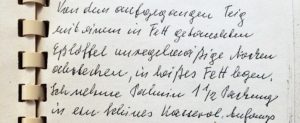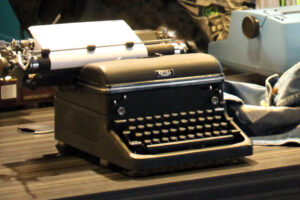A cache of family letters, or maybe even just one amazing letter written by an ancestor, is a great source for writing a story from family history.
Martha McCallum’s book Unknown Valor: A Story of Family, Courage, and Sacrifice from Pearl Harbor to Iwo Jima, or Sarah Wildman’s Paper Love: Searching for the Girl My Grandfather Left Behind are great examples.
However, you do not have to write a book. You can write one story based on a family letter, which is what I did with my story The Flying Dutchman. And that is my approach in my upcoming course From Family Letter to Fascinating Story: Focusing on transforming one letter (or set of letters) into a story.
Once you have selected the letter(s) you want to use (see my 5 tips for that), how do you begin the actual writing?
Here’s my number 1 tip for getting started in using a letter as the basis of a story:
Retype the letter.
That is, take the time and type up the whole thing. Every word the letter writer put down, you put down.
Why is retyping the letter such a good method?
- First of all, a practical reason: If the letter is handwritten (and most old letters are), typing it up will make it legible to later generations. I personally love handwriting. However, in many cases, it is hard to read. Scripts also change over time, and the skill of deciphering old scripts gets lost. My daughter already has a hard time reading my grandmother’s handwritten recipes. They are also in German, which makes them harder to read for her.

Detail from my grandmother’s notebook of handwritten recipes
- Another practical reason: It will be easier for you to quote from the typed version.
- The most important reason, however, is that retyping the letter is the best way to hear the writer’s voice. Recreating the writer’s sentences as you type, you will feel yourself into how he or she expresses him-/herself. It forces you to pay attention to every word. Thus, you get into the head of the writer. Letters are a great source for bringing someone to life on the page because they offer us that person’s voice.
- Retyping the letter also ensures that you actually know what the letter writer wrote, and not what you think he or she wrote. You’ve probably read the letter before and have a certain memory of it. But did you pay attention to every word? Did you actually hear what the writer wrote? Retyping it will ensure you do.
Retyping another writer’s work is, by the way, a tool great contemporary writers have used to hone their prose.
In her 1978 interview with the Paris Review, Joan Didion, one of the greatest writers of creative nonfiction, was asked which writer influenced her more than others. She answered:
“I always say Hemingway, because he taught me how sentences worked. When I was fifteen or sixteen I would type out his stories to learn how the sentences worked.”
Your letter writer most likely won’t be a second Hemingway, but retyping the letter you want to use in your story will give you a good handle on how he or she thought, felt and expressed him-/herself.
And getting that close to a character is gold in terms of storytelling.
 Interested in writing family history based on letters? Check out my upcoming online course:
Interested in writing family history based on letters? Check out my upcoming online course:
From Family Letter(s) to Fascinating Story
Begins July 10, 2022.

